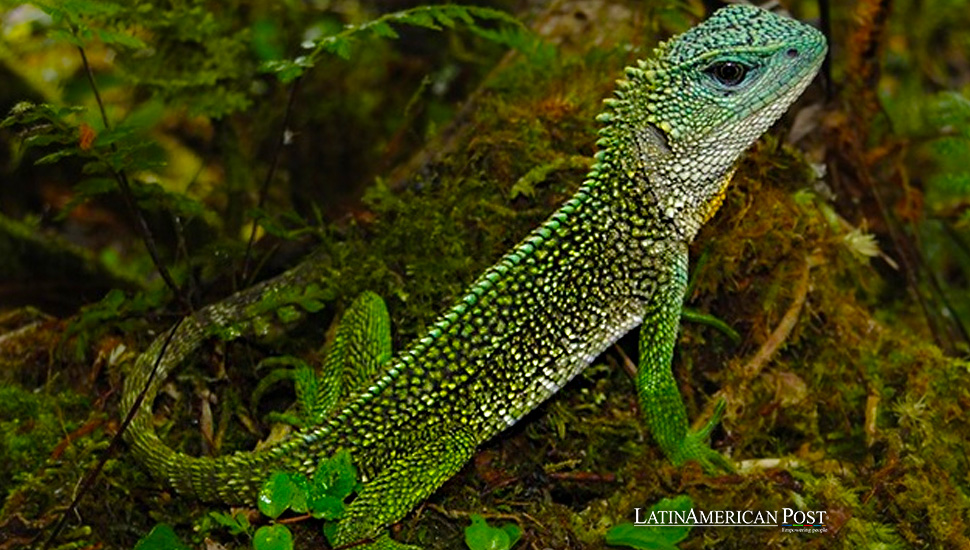A New Lizard Species Discovered in Peru Named in Tribute to Iron Maiden Singer

In a tribute to the legendary Iron Maiden frontman Bruce Dickinson, a group of international scientists has discovered a new lizard species in the Peruvian Amazon named ‘Enyalioides dickinsoni.’ This homage highlights Dickinson’s multifaceted career and unexpected connection to the natural world.
A Lizard Tribute to Bruce Dickinson
Deep within the lush expanse of the Peruvian Amazon, a group of multinational scientists has made an extraordinary discovery that bridges the worlds of heavy metal music and herpetology. The discovery of a new lizard species, ‘Enyalioides dickinsoni,’ pays a unique tribute to Bruce Dickinson, the legendary frontman of the British heavy metal band Iron Maiden. This gesture acknowledges not just Dickinson’s musical prowess but his diverse talents as a fencer, pilot, entrepreneur, and historian.
Dubbed the ‘Dickinson’s stick lizard,’ the decision to honor the multifaceted vocalist underlines the impact of cultural icons on diverse fields, including scientific nomenclature. The ‘Enyalioides dickinsoni’ was found alongside ‘Enyalioides hydrocephalus,’ inhabiting the humid montane forests of the Colán Mountain Range in the Amazonas region, as detailed by Peru’s National Service of State Protected Natural Areas (Sernamp) in a press release.
The discovery of these species is the result of a collaborative research effort by experts from Rainforest Partnership, the Peruvian Institute of Herpetology, and the Museum of Zoology at the School of Biological Sciences of the Pontifical Catholic University of Ecuador, with support from Sernanp personnel. This joint venture underscores the importance of collaborative efforts in uncovering the mysteries of biodiversity in one of the planet’s most vital ecosystems.
Rainforest Exploration: Unveiling ‘Enyalioides dickinsoni’ and ‘Enyalioides hydrocephalus’
The ‘Enyalioides hydrocephalus,’ or blue-headed stick lizard, is distinguished by the unique blue heads of some adult males. However, the researchers documented only two adult males with distinctive blue heads. Local communities in the Colán Mountain Range often refer to males of this species as the blue-headed chameleon, highlighting the species’ unique place in local lore and the broader ecological tapestry.
The distribution range of these newfound species is confined to the east and north of the Marañón and Utcubamba rivers, respectively. This geographical specificity points to the rich yet fragile biodiversity within the Peruvian Amazon, underscoring the need for ongoing conservation efforts to protect these and other undiscovered species. The common names proposed by researchers Pablo Venegas, Luis García-Ayachi, Juan Chávez-Arribasplata, Axel Marchelie, Santiago Bullard, Eduardo Quispe, Juan Valencia, Jasmín Odar, and Omar Torres Carbajal for these species are blue-headed stick lizards, reflecting both their physical characteristics and the awe they inspire.
Honoring Dickinson: A Crossroads of Culture and Science
The naming of ‘Enyalioides dickinsoni’ in honor of Bruce Dickinson is a testament to the enduring influence of cultural figures on scientific discovery. It’s a reminder of the interconnectedness of our world, where the legacy of a heavy metal icon can extend into the realms of environmental conservation and scientific research. This discovery not only enriches our understanding of the biodiversity of the Amazon but also celebrates the multifaceted contributions of individuals like Dickinson to global culture and awareness.
As we marvel at the beauty and diversity of the natural world, discoveries like ‘Enyalioides dickinsoni’ serve as powerful reminders of the importance of preserving our planet’s ecosystems. They highlight the role of scientists, artists, and individuals from all walks of life in fostering a deeper appreciation for and commitment to protecting the environment. In paying homage to a music legend, the scientific community has underscored the universal appeal of nature’s wonders and the critical importance of their conservation for future generations.
Also read: Puerto Rico Hosts Groundbreaking International Congress on Artificial Intelligence
This blend of music, science, and conservation offers a unique narrative that enriches our collective knowledge and cultural heritage. It exemplifies how inspiration from one domain can illuminate and elevate another, leading to a deeper, more interconnected understanding of the world around us. As ‘Enyalioides dickinsoni’ and its counterpart ‘Enyalioides cyanocephalus’ take their place in the annals of scientific discovery, they also stand as symbols of the unexpected ways in which art and science can intersect, fostering a richer appreciation for both the natural world and human creativity.




